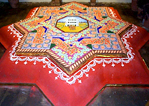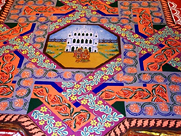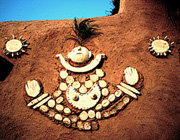



© 1999 VNN
|
WORLD October 11, 1999 VNN4917 Comment on this story Evening Blossoms BY FRIENDS OF VRINDAVAN  VRINDAVAN, INDIA, Oct 11 (VNN) — The Temple Tradition of Sanjhi in Vrndavana. VRINDAVAN, INDIA, Oct 11 (VNN) — The Temple Tradition of Sanjhi in Vrndavana. This post monsoon fortnight when traditionally the groves were filled with blossoms is the time in Vrindavan to view the coloured powder Sanjhis made by the Temple priests at the Temples of Sri Radharaman ji, Sri Radhavallabh ji and Sri Radha-Madanamohana. The design once made, is worshipped, and then also obliterated. Caption: October 8, 1999 at of Sri Radharaman ji Temple Vrindavan. The Sanjhi is created upon an earthen platform (vedi) measuring 6ft or more in diameter, over a period of between 50-100 man hours. A fresh design is made by the Temple priests each day through a five day period.  Caption: Intricately cut paper stencils are used to create layered patterns. Caption: Intricately cut paper stencils are used to create layered patterns. "This life is manifest in, among other things, the yearly calendar of festivals and festivities observed in Vraja utsava. As an example of an utsava, Sanjhi is an event of the autumnal season, after the rains. Significantly it occurs during pitr-paksa, the offerings to the ancestors, a bad time for all rituals or auspicious undertakings of any sort. But the creation of Sanjhi is a transcendental ritual of love that overrides the duality of temporal auspiciousness and auspiciousness. The early tradition, according to the mediaeval bhakti poets, was the creation of Sanjhi designs in flowers. Such a design is worshipped as a goddess in the evening (sandhya Sanjhi being a vernacular form of the word), specifically by unmarried girls for the purpose of obtaining a suitable husband. Nowadays, the tradition of Sanjhi is twofold: Sanjhis of cowdung and flowers created in the homes by women, and Sanjhis of coloured powder created in certain Temples of the Vraja area by the temple priests" Afterword by Shrivatsa Goswami, Senior priest of Sri Radharaman ji temple, Vrindavan.  Caption: Village Sanjhi created out of items stuck into a wall of fresh mud plaster. Caption: Village Sanjhi created out of items stuck into a wall of fresh mud plaster. This is an excerpt from the publication: - Evening Blossoms - The Temple Tradition of Sanjhi in Vrndavana . Published 1996 by Indira Gandhi National Centre for the Arts (I.G.N.C.A.) & Sterling Pub. New Delhi. ISBN 81 207 1645 0 By Sri Asimakrishna Dasa (1944-1997). Born in New York City he came to India in 1969 and never left Braj. Photos: Sri Jagadishlal Goswami, Sri Radharaman Temple, Sri Shrivatsa Goswami and Robyn Beeche. The book can be sourced for you through (Friends of Vrindavan) gambhira@vsnl.com in Vrindavan. Or online via I.G.N.C.A http://www.nic.in/ignca/ although the publications lists are not yet deployed. "KSETRA SAMPADA - http://www.nic.in/ignca/ks_body.htm The area of Vraja has been a centre of many socio-cultural movements. Contemporary Vraja presents a micro-model of living continuities of the past. A beginning has been made by compiling a multi-lingual bibliography of secondary sources and a database of unpublished manuscripts. Audio-visual documentation of the rituals in the temples has also been carried out. Alongside, architecture of the temples is being recorded and activities of the temple is researched to study the impact of temple tradition of Vrindavan. Comment on this story
|